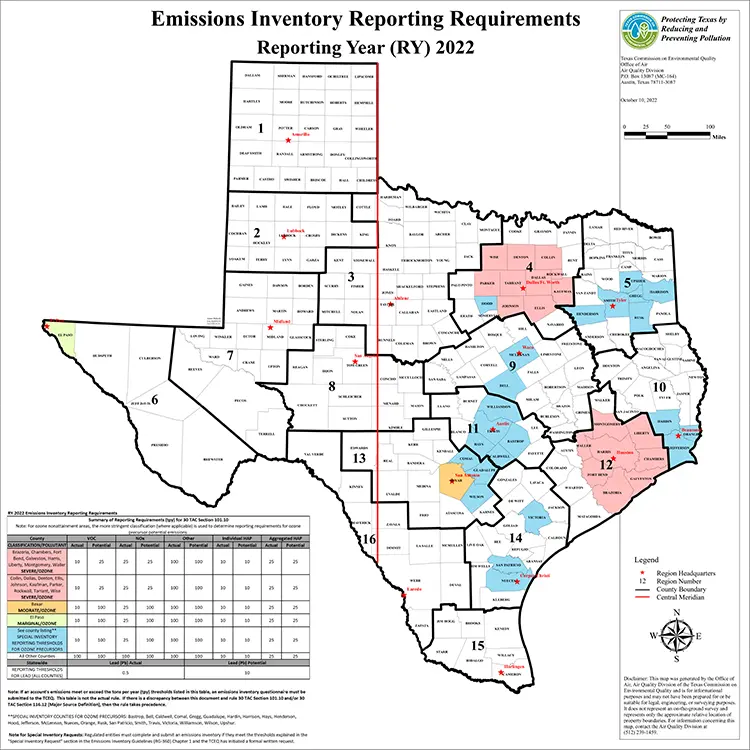Annual Emissions Inventory and Reporting Requirements
Something’s in the Air
New Year’s vibes, right? Perhaps! But for those of us who must file air permits, the beginning of the year is an important time, because multiple annual reports are due by the end of the first quarter.
At Apex Companies, our team is busy preparing point source emission inventories, greenhouse gas reports, and Tier II chemical inventories. There are other reports as well, like annual Title V compliance reports, Mass Emissions Cap and Trade (MECT) annual compliance reports, etc. While most of these are due at the end of Q1, there are exceptions; Title V compliance reports aren’t always due in Q1. Instead, many agencies require them annually based on the permit issue date. Navigating the annual reporting landscape can be daunting. Why is this?
Emissions Inventory Reporting: Ins and Outs
While the US Environmental Protection Agency (EPA) maintains annual emissions inventory data, they require state and/or local agencies to collect and report the emissions data for their geographic areas. The delegated agencies have flexibility in how they collect that data, so the requirements are different depending on where a facility is located, what its potential and actual emissions are, and its air quality authorization status.
 Unfortunately, the specifics of who must report, what must be reported, and when the reports are due vary widely by state (and in some cases, local agencies). Take Texas emissions inventory reporting requirements for example, where several non-attainment areas make reporting much more complicated. If you aren’t familiar with non-attainment areas you can think about it like a whole area failing a test and getting put on a performance improvement plan. Or California Air District Rules, where there are 35 local Air Pollution Control Districts (APCD) and Air Quality Management Districts (AQMD) that regulate stationary sources in the state. The Colorado Department of Public Health and Environment requires an Air Pollutant Emissions Notice (APEN) for certain businesses that emit air pollutants, but determining if you need to submit an APEN isn’t simple. You must identify sources of air pollution, determine which ones are exempt, and whether you have had a “significant change in emissions” year over year.
Unfortunately, the specifics of who must report, what must be reported, and when the reports are due vary widely by state (and in some cases, local agencies). Take Texas emissions inventory reporting requirements for example, where several non-attainment areas make reporting much more complicated. If you aren’t familiar with non-attainment areas you can think about it like a whole area failing a test and getting put on a performance improvement plan. Or California Air District Rules, where there are 35 local Air Pollution Control Districts (APCD) and Air Quality Management Districts (AQMD) that regulate stationary sources in the state. The Colorado Department of Public Health and Environment requires an Air Pollutant Emissions Notice (APEN) for certain businesses that emit air pollutants, but determining if you need to submit an APEN isn’t simple. You must identify sources of air pollution, determine which ones are exempt, and whether you have had a “significant change in emissions” year over year.
In general, most major sources (Title V, nonattainment, or Prevention of Significant Deterioration) are required to calculate and report actual calendar year emissions by sometime between the end of January and mid-April each year. Whether minor sources need to report their actual emissions is much more varied. Some states are more stringent and require businesses with any kind of air permit to submit an emissions inventory report every three years. Other states provide an exemption for sites with certain types of authorizations (generally Permits by Rule), several states exempt sites with potential or actual emissions below certain thresholds, and most states have different requirements for sites located within designated nonattainment areas versus those in areas that are in compliance with all National Ambient Air Quality Standards (NAAQS).
The data that must be reported varies as well. Some states only require a few pollutants to be reported, while others require all criteria pollutants and hazardous air pollutants (HAPs), as well as additional volatile organic compound (VOC) speciation above certain thresholds. Some local reporting agencies require detailed reports with all calculations and supporting documentation; others just require you to enter actual operating data in an online database.

Source: Texas Commission on Environmental Quality. 2022. Emissions Inventory Reporting Requirements Reporting Year (RY) 2022.
Let’s travel back to Texas. If you take a look at the Emissions Inventory Reporting Requirements map we shared earlier that shows the state and its regions, along with areas with special reporting requirements, you can see there are different thresholds for reporting based on actual and potential emissions according to the nonattainment classification of the area, in addition to a handful of counties with special inventory reporting thresholds for ozone precursors. Any site in the state with actual or potential emissions above Title V major source thresholds is required to report annually, as well as any site with actual lead emissions of 0.5 tons per year (TPY) or potential lead emissions over 10 TPY. Sites that are required to report and are located west of the red central meridian line only need to report actual annual emissions. Sites located east of the line also must report their actual average daily emissions during the ozone season (May through September). And sites that exceed the thresholds for reporting but have an actual change in emissions of less than 5 TPY per pollutant vs the previous year can submit an insignificant change letter rather than a full report, but they can only do that a few years in a row before they must do a full report again. That’s just the variation within Texas, which doesn’t even have a triennial reporting option like many other states do.
Greenhouse gas reporting (under the Mandatory Greenhouse Gas Reporting Rule, 40 CFR Part 98) is much more consistent because the specifics of the reporting requirements are mostly spelled out in the Code of Federal Regulations (CFR) and the EPA runs the program directly. However, there is a lot of variation across the multiple industries (41 industrial categories) the rule applies to. Annual GHG reports are due by March 31 each year for the previous calendar year.
Tier II Reporting
Tier II reporting is required under the Emergency Planning and Community Right-to-Know Act (EPCRA) (SARA 312) and is another federal program managed by state and local agencies, so again, there are many differences based on location. However, it’s generally not as varied as emissions inventory reporting, except when it comes to how the data is reported. Tier II reporting isn’t actually an air quality report; it’s an annual compliance report that documents a facility’s usage of hazardous chemicals. Tier II reports are due March 1 each year for the previous calendar year. In general, these reports are required for storage of chemicals above the following thresholds:
- Hazardous chemicals (by OSHA criteria): 10K lbs
- Extremely hazardous chemicals: 500 lbs or the threshold planning quantity (TPQ), whichever is less
- At retail fuel stations:
- Gasoline: 75K gallons
- Diesel fuel (all grades combined): 100K gallons
There are exemptions and some states have more stringent requirements. Also, a local or state emergency response committee or fire department can request Tier II reporting with no minimum threshold.
If you found this article interesting and would like additional information or to speak with a knowledgeable Apex professional about your specific air permitting and reporting needs, please contact us at info@apexcos.com or fill out our Capabilities Inquiry form. Good luck this reporting season, and Happy New Permit Year to you!
Apex Associated Press (Apex AP) represents contributions from various authors within the Apex professional community.
Disclaimer
Please note that all content provided on this blog is for informational purposes only and does not necessarily represent the views, opinions, strategy, or methods of Apex Companies, LLC (Apex). Apex makes no representations as to the accuracy or completeness of any information on this site or found by following any link on this site. Apex will not be liable for any errors or omissions in this information nor for the availability of this information. Apex will not be liable for any losses, injuries, or damages from the display or use of this information. Apex reserves the right to edit or delete any comments submitted to this blog without notice to whoever wrote, submitted or posted the comment. Anyone who submits or posts any material to this blog waives any right or claim to privacy with respect to the content submitted or posted. By submitting or posting any content, the person or entity that does so is representing that they believe it to be accurate, have a legal right to the content, and have legal authority to submit or post it. Please do not submit or post anything if this is not the case. Please consider these requirements carefully when submitting or posting comments, photographs or other material relating to third parties who may have privacy, ownership or other rights implicated by the content. Readers are encouraged to seek professional legal, scientific, and/or engineering consultation concerning specific environmental, engineering, or other concerns. If you would like to contact Apex for more information regarding professional consultation to address your specific concerns, click here.
